Hour of
Yokai
Project developed during the Post-grad course in Game Design at George Brown College
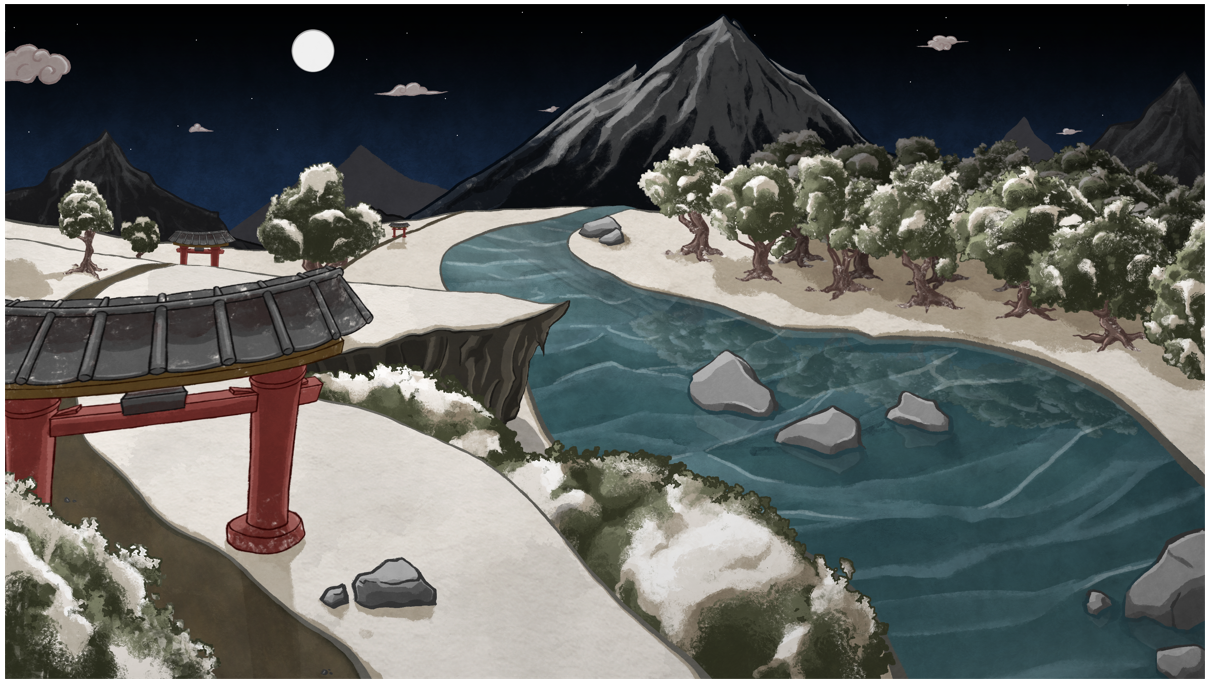
Hour of Yokai is a Puzzle Adventure Game
Hour of Yokai was a game prototype developed in two semesters as part of the George Brown Post Graduate Course in Game Design. I worked alongside colleagues Victoria Rex and Alexander Thompson, as well as Ashley Sterling Lopez and Sofiya Skliar from the Game Art Program.
We went through the process of creating the idea from scratch, pitching the game, and then recruiting undergrads to work with us during the development process, taking the roles of managers and project leads.
Coming up with the idea
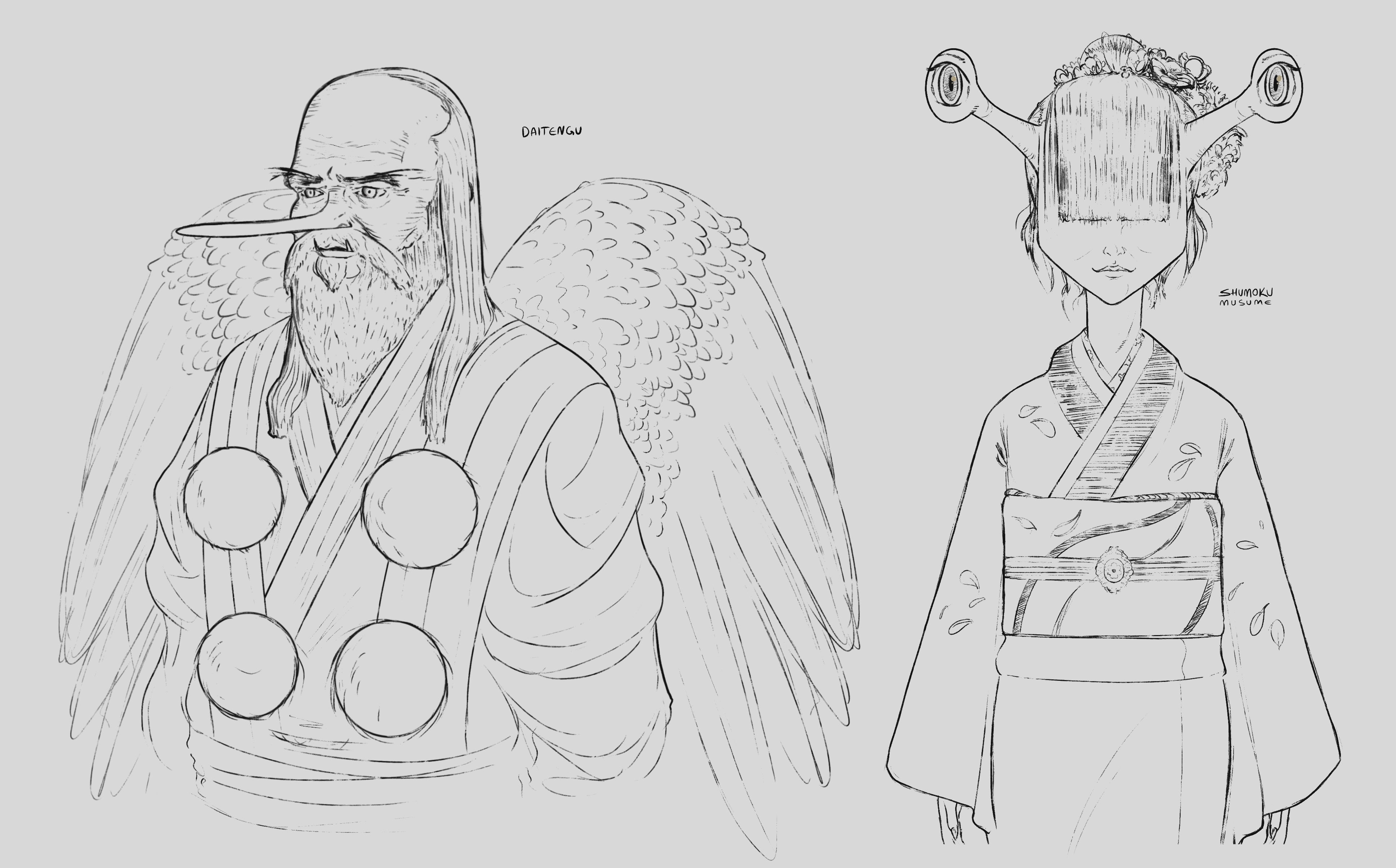
Daitengu and Shumoku are two Yokai, NPCs that can be encountered in the game.
Our initial group was prompted with the phrase "Sacrifices Must Be Made" by the professors and, after that, we were given one week to prepare an original game idea and pitch it to make it go into production. We started by trying to dissect the phrase and think of what we understood as a "sacrifice". Overall, the thought of "sacrifice" really meant to "leave something behind in order to gain something else". To sacrifice something is to make an exchange, you give one thing and in turn, receive another. That's how we were able to make sense of the idea.
So what is this "something" that you are giving up? Our minds went directly to the idea of life energy, or force, similar to blood sacrifices for example. Initially, we even discussed ideas of a darker tone such as a Death Game in which you control a party of characters but have to sacrifice some in order to proceed. This type of tone didn't get very far but we did settle on the idea of giving up energy and resources in order to proceed.
After settling on some basic meaning of the initial prompt, we started discussing other interests such as art style, setting, and so on. We gravitated towards Yokai, bewitching spirits from Japanese mythology and folklore. They are evocative figures that range from extremely creepy and evil entities to some that are just very weird and actually a little cute. At this stage, we also discussed the type of game that we wanted to make based on our discussions. A puzzle adventure game felt like it would work well with the setting and the overall prompt.
We decided that Hour of Yokai would be an Adventure Puzzle Game, in which the player would need to collect items and use them to solve puzzles. However, every item could only be used once, and using items requires energy, so the player would need to be strategic in order to proceed through the level and save their most valuable items as well as their energy in order to reach the end. The player would take the role of Tama, a spirit with no memory of their life or death, in a quest to seek closure about their life. They require energy to use the items because they are not really meant to be tethered to this world.
Full map breakdown
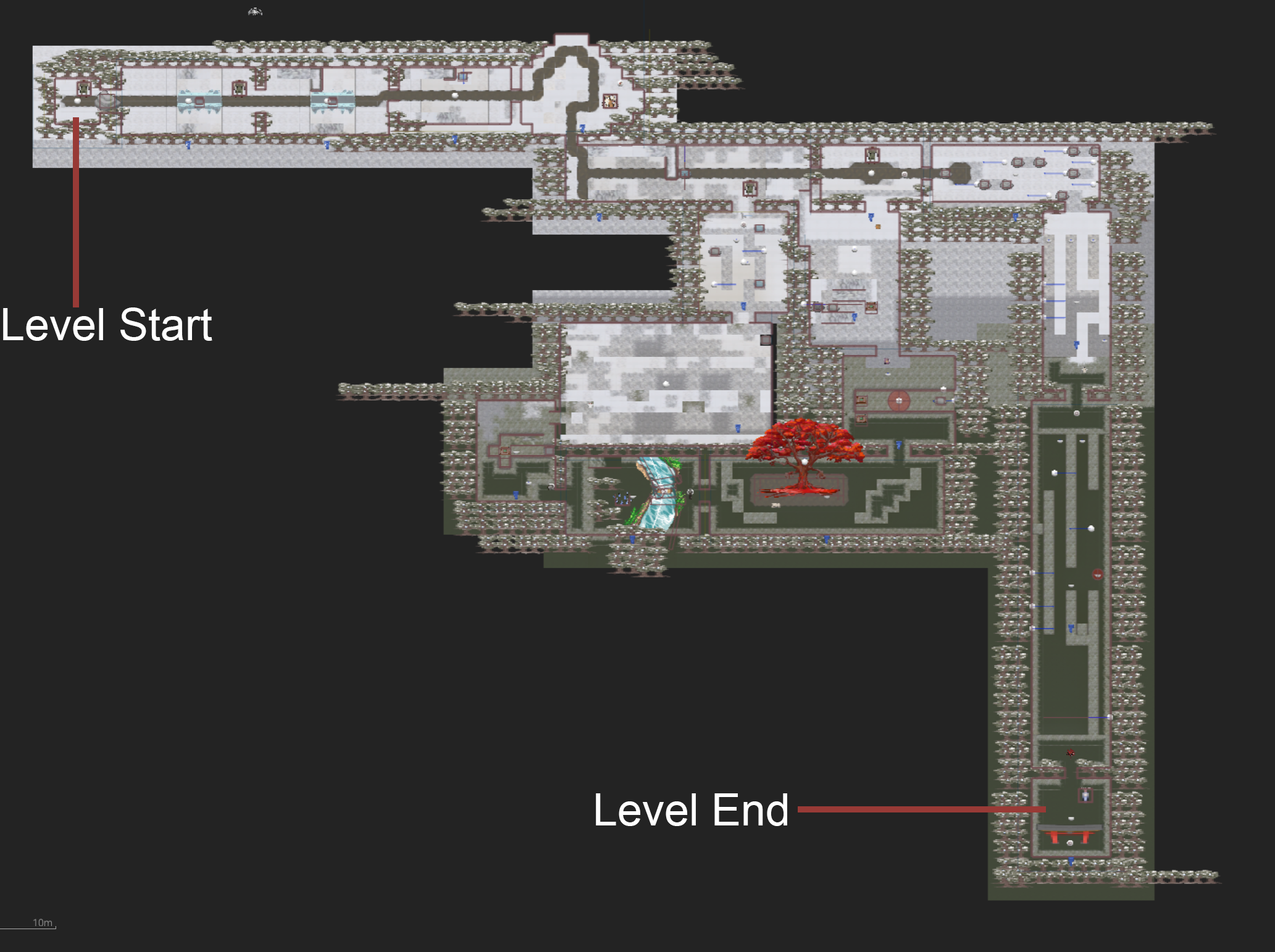
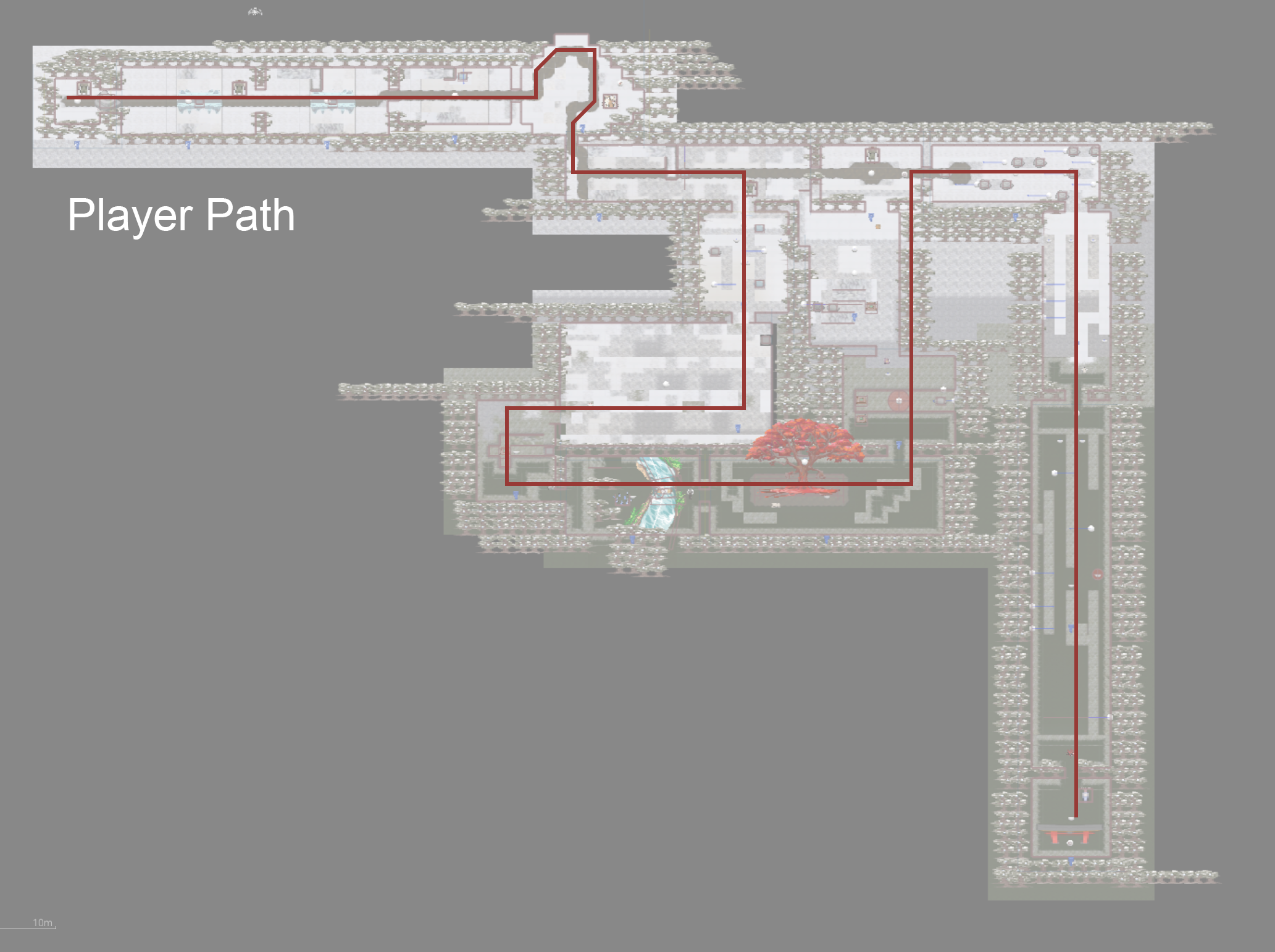
This is the path that the player will take throughtout the tutorial until the end.
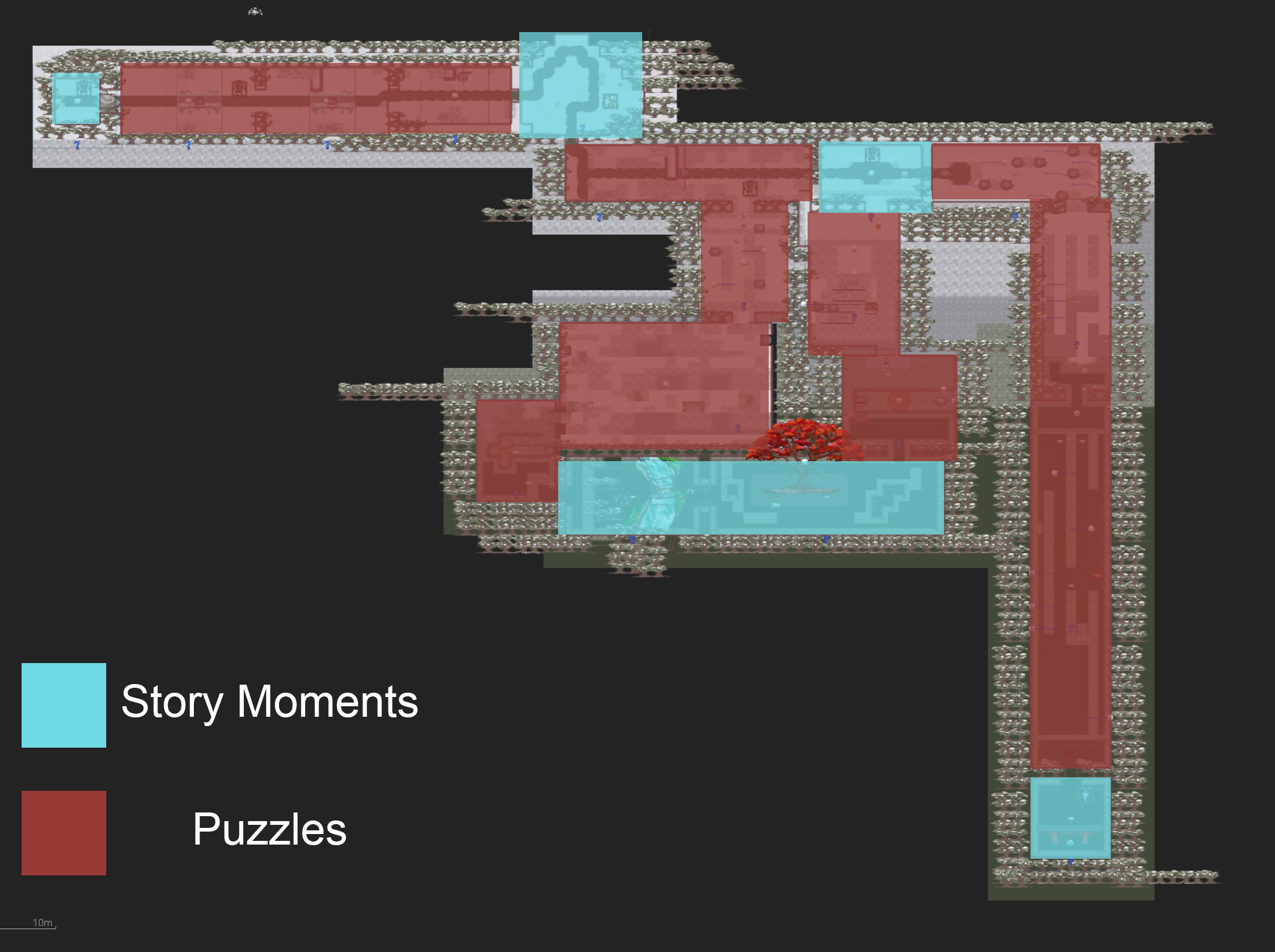
This shows the moments in the Tutorial level in which the player is expected to deal with only Story and NPC dialogue in contrast with the puzzle sections of the game.
We try to have some puzzle sections close together and then break it up with a small pause for story and NPC dialogue.
Important Notes for Level Design
Hour of Yokai is a Puzzle Game, so part of the experience is to make the player feel smart.
For that to be possible it is important to start with smaller and simpler puzzles for the player to understand the rules of the game.
During the game the player can find the following obstacles:
- Spiritual Obstacles, such as bridges and rocks that are still on the Spiritual Plane. They don't collide with other obstacles and are not affected by gravity.
- Wind gusts that push the Player and Spiritual Obstacles away
- Material Obstacles that collide with the player and other obstacles and are affected by gravity. These obstacles can also be cracked so they will break if something impacts it
Player Mechanics
The game is composed of one tutorial level and the player has access to two powers during the entire game. They are:
- The can transform Spiritual Obstacles into real ones, which allows them to collide with the player.
- They can transform themselves into a Rock Version of Tama, which allows them to resist wind.
The first Power is available from the start of the game while the second one is only available to the player after the middle part of the level. This decision is meant to not overwhelm the player with too many possibilities right at the start of the game.
Teaching these mechanics to the player
The goal for the initial puzzles was to teach these mechanics to the player one by one.
Another important aspect was the Wind obstacle and how it relates to the player not being able to overcome it straight away.
Instead of just dropping the Wind obstacle on the player at the same time that they gain the means to beat it, we placed it earlier on the level, forcing the player go suffer with it.
This meant that when the player got the ability to resist Wind, it would have a larger impact for them. The starter progression for it is as follows:

Initial 4 puzzle progression. We add a "Gate" on the fourth puzzle in the form of a Wind obstacle. The player must go through another path to beat the level.
Later they wil reencounter the same obstacle but with a way to get past it.

The position of the gate on the tutorial map
The First Puzzles
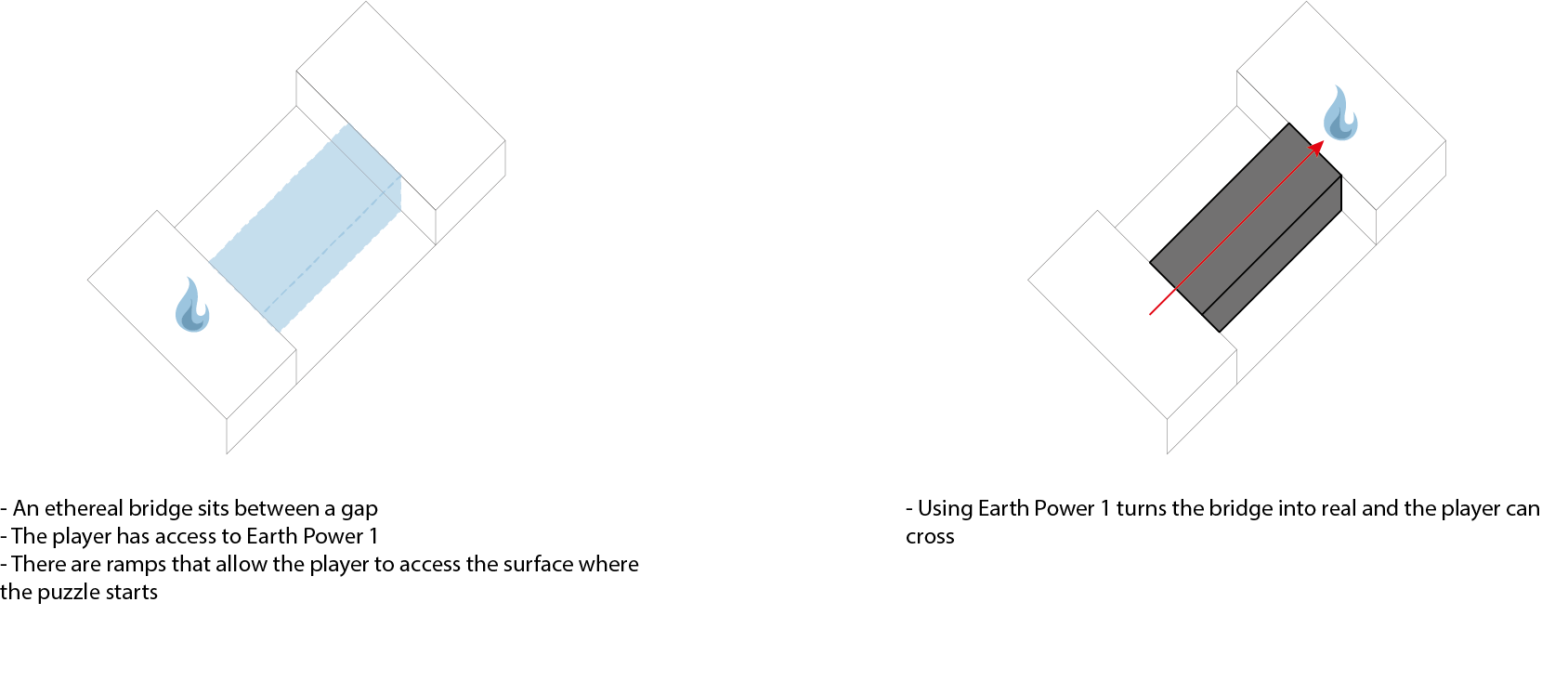
The first puzzle is one Spiritual Bridge that the player must transform into a Material Bridge.
There is a gap in the middle of the room and the player falls into it if they try to cross the spiritual bridge.
Using their first power the player can turn the Spiritual Bridge into a Material one and cross the gap
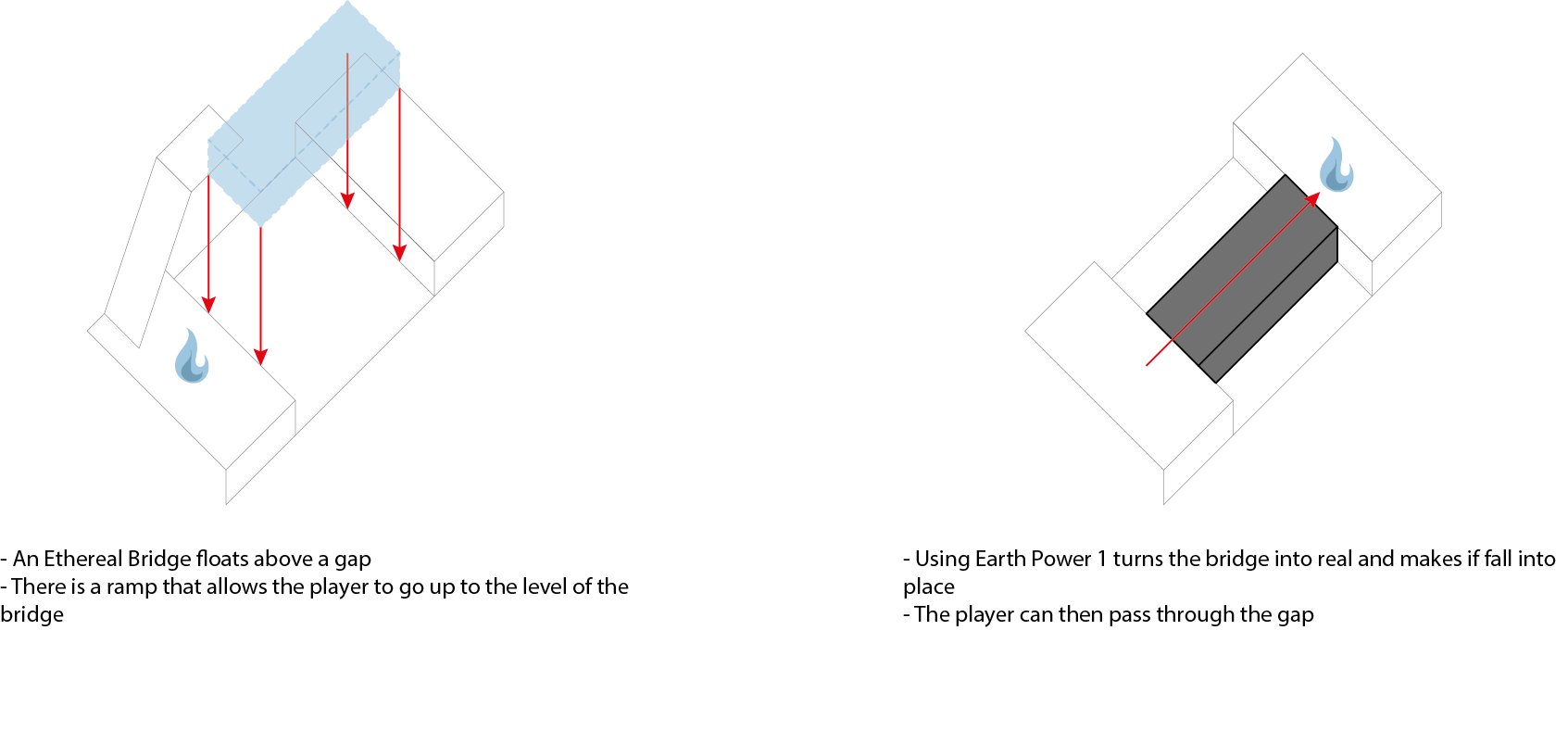
Similar to the first one, the second puzzle features a Spiritual Bridge that must be turned into a material one by the player.
The difference here is that the bridge is suspended in the air, showing that Spiritual Obstacles float and Material ones will fall to the ground.

The goal for this puzzle is to teach the player about how Wind mechanics work.
There is a narrow path that takes the player from one part of the room to another, but wind is constantly blowing there.
If the player tries to cross it, they will be pushed to the side.
There is also a Spiritual Boulder above the wind. If the player turns it into a Material one, it will block the wind, allowing them to pass.
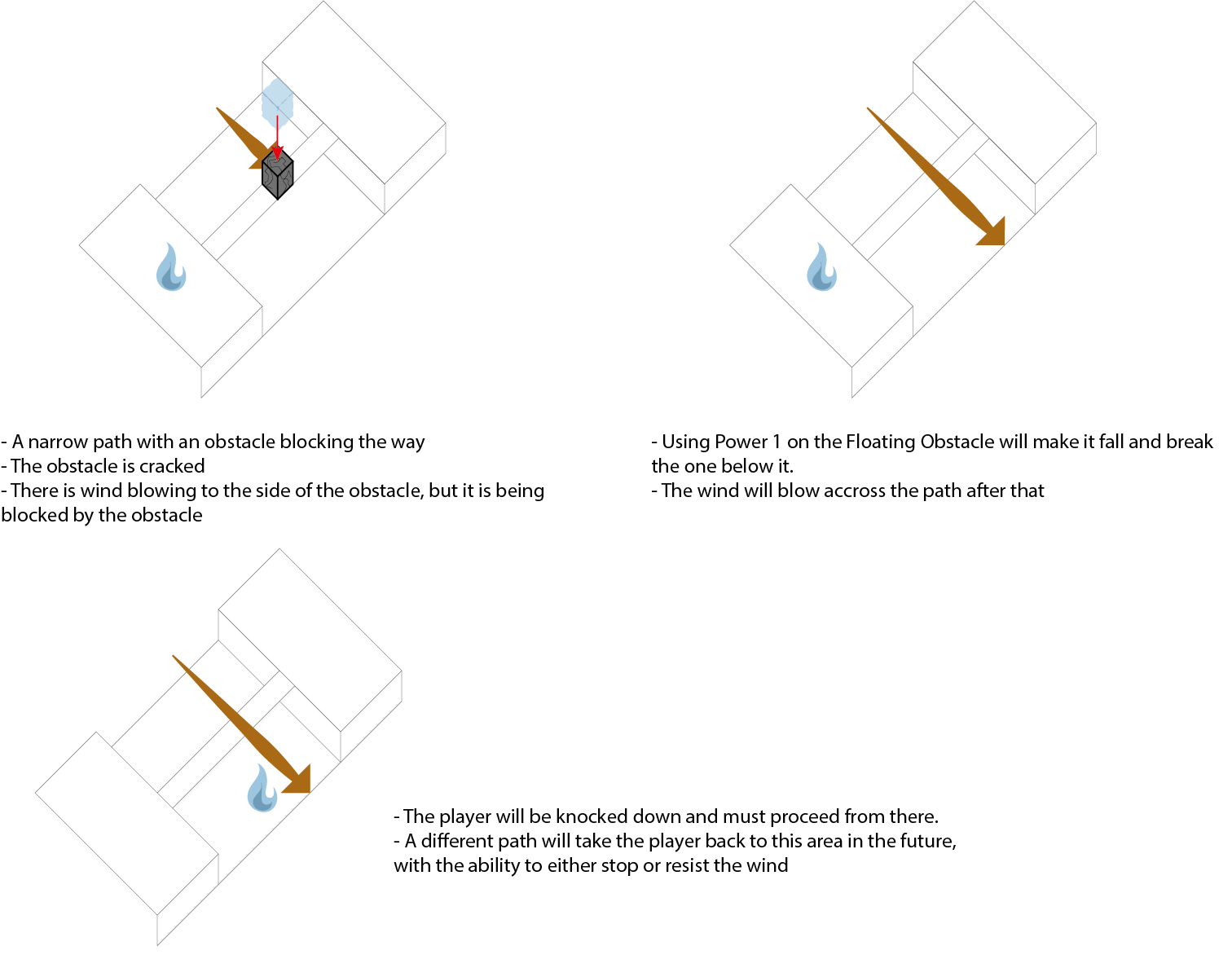
This is the last puzzle for the early tutorial moment that aims to teach the player about the different mechanics.
It features a narrow path with a Cracked Boulder in the middle. The boulder blocks the path and there is also wind blowing against it.
The player can turn a Spiritual Boulder that floats above the Cracked one into a Material Boulder. As it falls, both will break on impact, clearing the way.
However, the player is pushed out of the narrow path by the wind and falls from it, so they must seek a different path to reach the end of the tutorial.
The rest of the level
The rest of the level presents other puzzles mixed in with Story Beats to create the sense of a journey that the player is going through.
We combine the previous elements into new puzzles for the player, making them more complex as they go. These combinations can be:
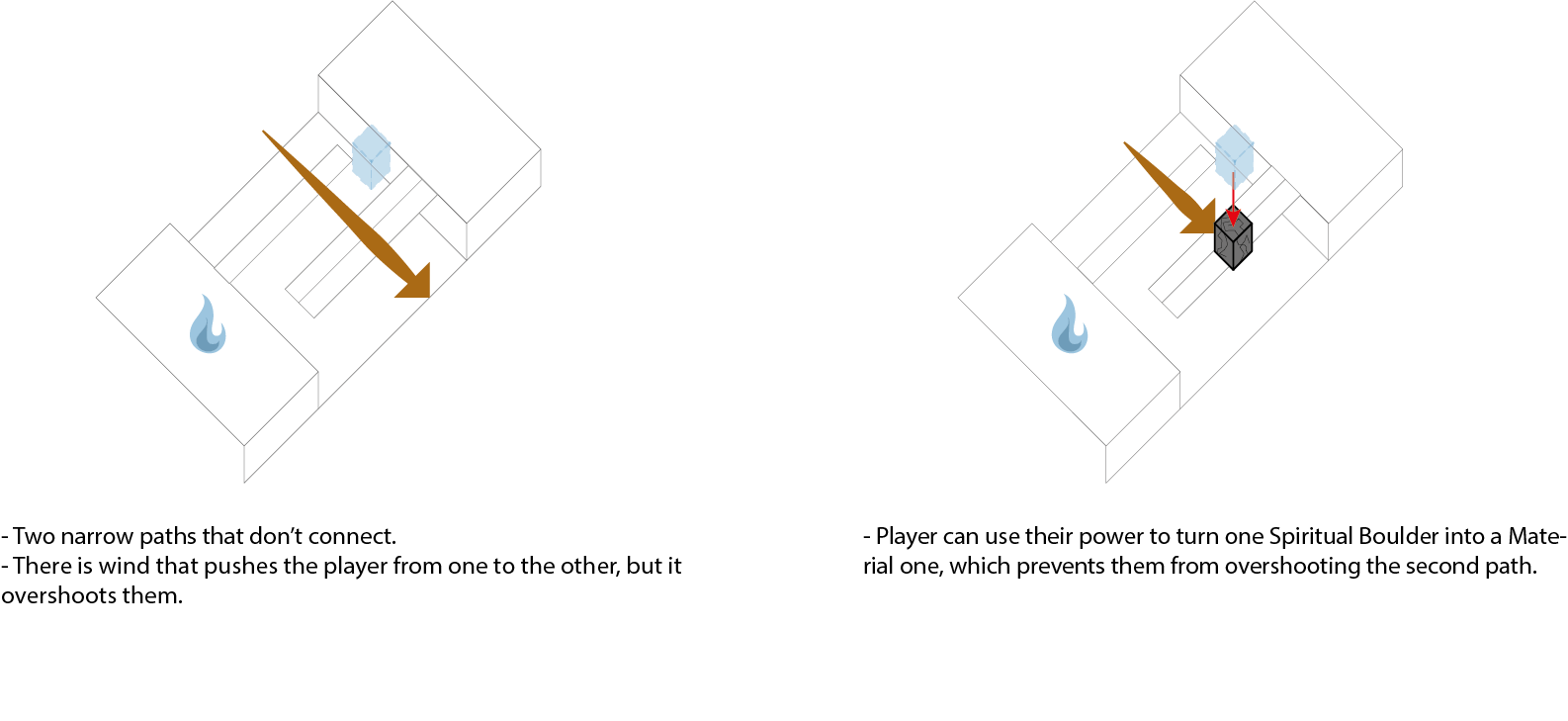
Wind pushing the player from one narrow path into another and the player using a Material Boulder to block them from overshooting the second path.
This combination of elements can be rearranged across the level and can be even further combined with other pieces in order to increase complexity.
The entire tutorial level design followed the same pattern of introducing a concept to the player and then working it into different scenarios. As the player moves through the level, the complexity of each puzzle increases, but so does their mastery of the mechanics of the game.
The Initial Design Process
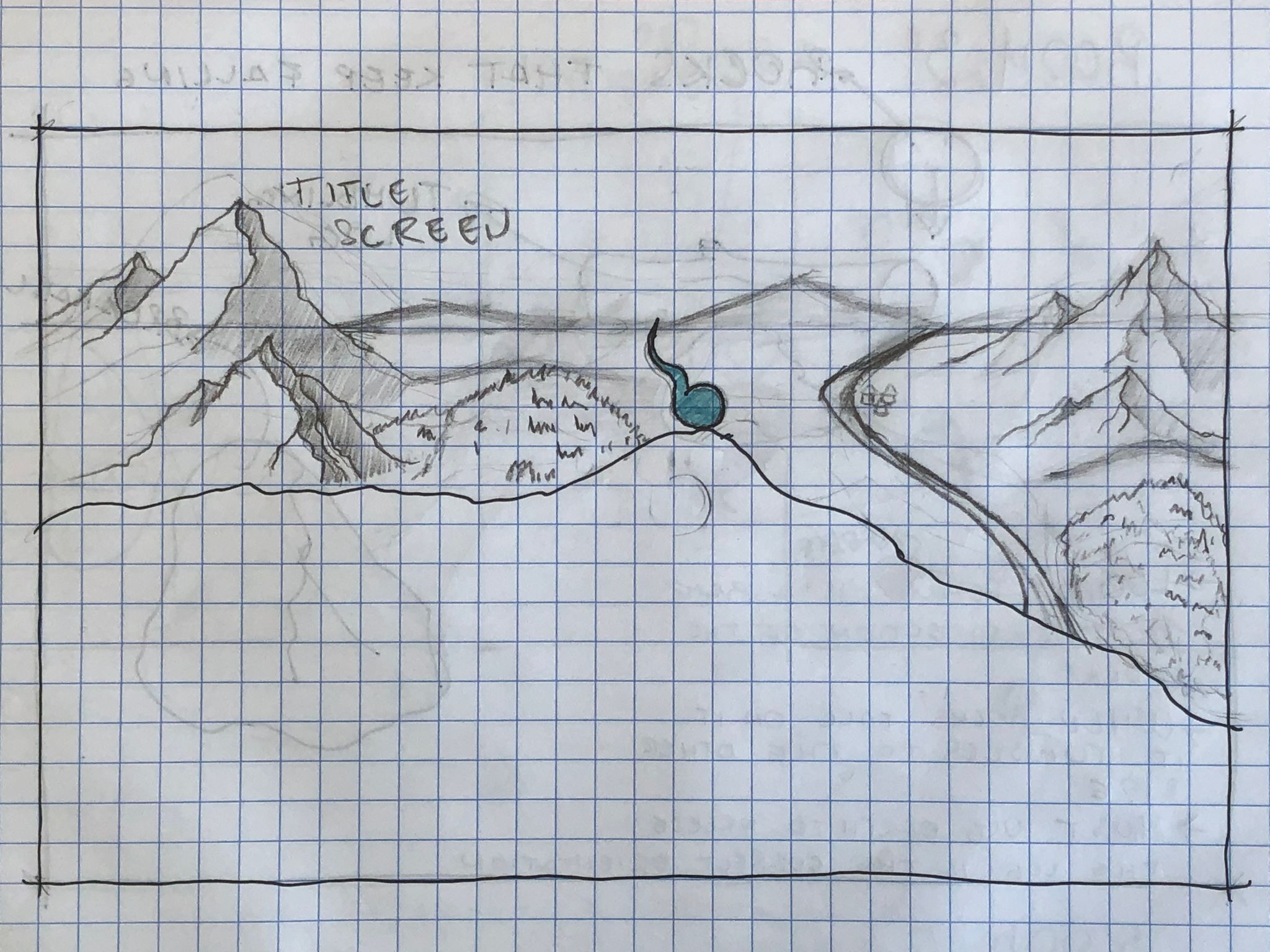
First drawing for a title screen.
As we started with production we tried to define the game as much as possible before proceeding and we created three pillars to guide us in our development of the game. Those were:
- Sacrifice in Order to Proceed
- Encourage Exploration
- Japanese Folklore
We wanted to keep the idea of sacrifice as an important cornerstone in the game. The player needed to feel like they were making an exchange in order to continue through the game. We also wanted the game to be open ended and have multiple branching paths, this would reinforce the idea of sacrifice because choosing to go down one path, possibly meant not having enough energy to go down another. Finally, as we were using Japanese folklore in our narrative, we wanted to be as accurate as possible to it as we could.
We then started breaking down those initial concepts into more bite-sized ideas. Some questions that we had were "What is a puzzle?" "What are items?" "How do you use an item?" and so many others. At this stage, items were a pretty big part of our design so we started by defining those. We also wanted to get away from a simple "lock and key" logic in which you would have to get the correct item for the correct key.
Our answer to that was to come up with a Type and Powers. Items would have 'types' such as Earth, Wind, Fire, and Water and each type would give the player certain powers. For Earth, for example, the player would have the power to bring objects from the Spirit Realm into the Material Realm or make them completely immoveable.
For obstacles we also created a system for how they should work but that was based on the idea of variations. For example, a rock. The rock could be a Real or Spirit Rock, it could be cracked or whole. Each variation meant that the obstacle would be interacted with in different ways. Cracked obstacles break when something heavy falls on top of them, Real obstacles are affected by gravity while Spirt obstacles float and so on.
Overall we tried to create rules that we could follow during implementation in order to make it modular. With that, we could implement the game in a modular fashion as well and it would be easy to isolate something that needed to be redesigned or scrapped.
The constant hurdle of time
It is obvious that game design and game development take time, but we were not aware of just how much time that was exactly. It was inevitable that certain design ideas would not see fruition because of it, especially considering our short development time.
One of those was the idea of branching paths. Designing one set of puzzles that make sense, grow in difficulty, and remain interesting for the player already takes time. If each path was going to be a new set of puzzles, then having just one more path could double the time required to implement the game. We opted to focus our effort on what would be a tutorial level, with no branching paths.
For our deliverable, we opted for one single level which would be the tutorial. Our focus was to teach the player the core mechanics of the game and introduce at least one Item Type.
Arcs and Player Experience
The Item Arc
In Hour Of Yokai the player will gather Items and use their powers in order to solve puzzles and overcome obstacles. Items may have one or more Item Type those being Earth, Water, Air, Fire and Void and each item Type gives access to three different powers
For the scope of the Vertical Slice that we delivered, we only designed and implemented the Earth Powers, which is what the player will use during the tutorial. For a full game the idea is that the player would gradually find new items and learn how to use the new powers.
We will also give the player these powers gradually, so they will not be overwhelmed with information at the start. For convenience we will refer to these powers as Power 1, Power 2 and Power 3.
The player will start the game with only Power 1 available to them, and it'll be the only way to interact with Obstacles. The first obstacle is an Spiritual Bridge that they must cross to go to the other side. Once they attempt to cross, they will fall through the bridge as it is not Material yet. Using Power 1 on the Spiritual Bridge will make it real and allow the player to cross. The following two screens will also use only Power 1 in order to reinforce that mechanic and really drive down how Obstacles react to this power.
So the basic Item Arc for the player is:

The Item Gameplay Loop
As the game progresses, new powers are gradually introduced to the player until they eventually have a wide range of options of how to deal with obstacles.
The Obstacle Arc
As previously stated, the player will interact with obstacles throughout the game. These obstacles work by having Variations applied to them and each variation means a different behavior. For example, the player can't touch Spiritual Obstacles, but they can touch Material ones. As with powers, variations will be introduced gradually to the player along with the powers so they will have the chance to identify different scenarios and how to use the powers that are available to them.
- Material Obstacle: This obstacle is affected by gravity and can block player movement
- Spiritual Obstacle: This obstacle is not affected by gravity and does not block player movement
- Cracked Obstacle: This obstacle breaks if something falls on top of it or if it falls from a great height. It will only break if it's in a Material State
Some obstacles, however, are only environmental ones and don't have variations applied to them. These obstacles are a constant effect on an area of the map and cannot be interacted with directly
- Wind: A strong gust of magical energy that pushes Tama and Spiritual Objects away
- Destroy Spiritual Area: A circular area that damages spiritual entities that pass through. If a spiritual obstacle enters it, it will be destroyed.
On the first screen of the game the player will face an Spiritual Obstacle, and using Power 1 they will turn that obstacle into a material one. On the second screen they will once again face an Spiritual Obstacle but this time it will by floating in the air. Turning it into a Material obstacle causes it to fall down, thus teaching the player another property of Material Obstacles.
The Obstacle Arc can be described as:
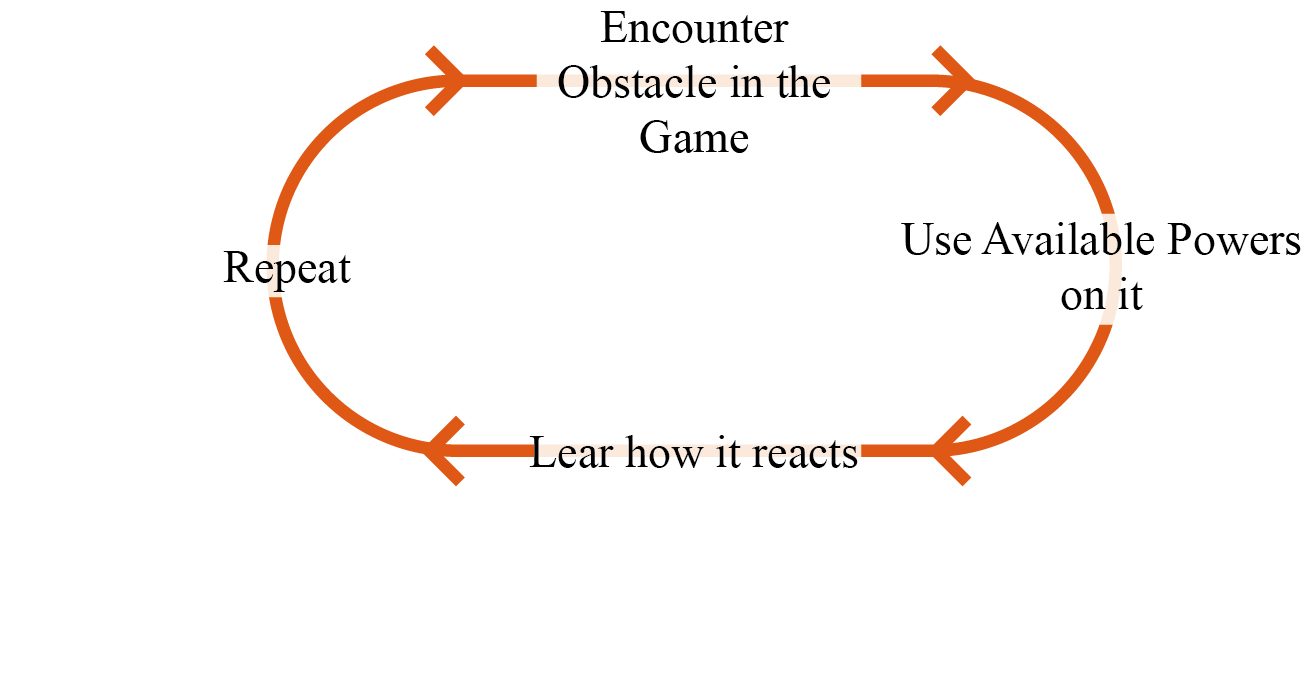
The Obstacle Gameplay Loop
The Narrative Arc
A core aspect of Hour of Yokai is the story and the emphasis on the titular yokai NPCs. As with any story, there is a beginning, a middle, and an end. Even within those divisions it can be divided into smaller beginnings, middles, and ends. If Hour of Yokai were to continue to a full-fledged game, the story would be as follows:
Beggining
The player is introduced to the playable character, a nameless hitodama (literally "human ball"; it is the soul of a deceased person) referred to as "Tama" by the yokai they come in contact with. Tama has no memory of their past life - not their gender, age, or reason for passing - and their confusion is keeping them tethered to the physical world instead of moving on. Their presence disturbs the mighty daitengu of the mountain and he takes it upon himself to teach Tama how to harness the power of the elements in order to pass through the barrier between the yokai world and the human world. Doing so, Tama can look for clues to figure out what happened to them so that they can either pass on in peace or grow in malice and become a proper curse.
Middle
Tama continues past the mountain and ventures through the barrier, but Tama is not the only yokai doing so. Seemingly frightful creatures are at every turn of Tama's journey posing as obstacles and providing information that helps give Tama insight on the surroundings and provide possibilities on how Tama met their end. Tama travels through a thick forest, crosses a river, and explores another smaller forest before they finally enter the village that they were drawn to.
End
After exploring the village, Tama realizes that there is one last stop for them: the castle keep just past the village. There, they find a small memorial splashed with mud from a recent rainfall. After clearing the mud, Tama sees the name engraved in the memorial and their memories flood back. The memorial was hers. She was a young orphan who lived in the village with her younger brother. While in construction, the castle keep would crumble no matter how hard the builders attempted to enforce it. It was decided that a human pillar (hitobashira) was to be placed within the foundation as a sacrifice to keep the structure sound. Tama was sickly and volunteered to be the sacrifice so long as her little brother was taken in by the aristocrats of the castle to live a better life. Tama floats up to peek into the windows of the castle. Once she sees her brother fast asleep, she returns to a human form and hugs him before passing on, happy her terms were met and that her brother will get to live a good life.
For the vertical slice, only what was illustrated as the “beginning” will be playable, but even within that distinction, there is a beginning, middle, and end. Tama meets the daitengu and learns about Item Types. Tama explores the mountain to prove their skills, and Tama completes daitengu’s tests and passes through the barrier.
Heuristics
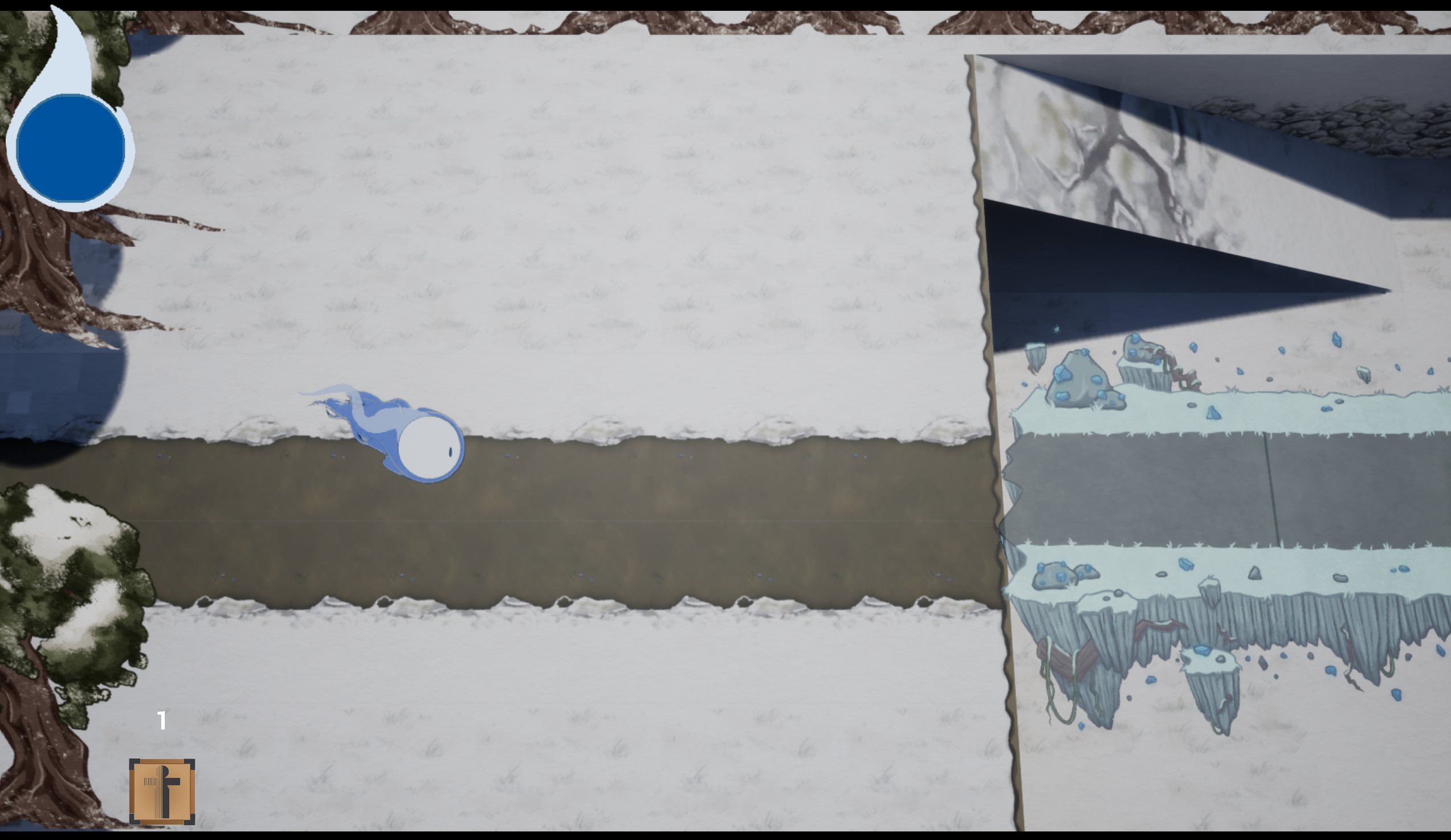
Tama facing a spiritual bridge
Thinking and Strategizing
Beginner players will likely adopt a strategy of "use item first, ask questions later" in regards to reacting to obstacles. Meaning when encountering an obstacle, they use whatever item they have on them immediately instead of potentially saving it for later. Through the early stages of the tutorial, in order to teach the mechanics, new players will be faced with scenarios where they are presented with an item, immediately followed by an obstacle they're supposed to use it on. And as they get farther, and are presented with the more open areas that allow them to tackle obstacles in an order of their choosing, they'll likely want to use the first item they have, on the first obstacle they encounter. A strategy that may prove moderately successful, but they'll find themselves in situations where they may be locked out of certain side objectives, as they missed things by not thoroughly exploring, as well as no longer having items of a particular element when it might be useful.
Once becoming more experienced, players will adopt a strategy of thoughtful planning. They'll be inclined to explore any given area first, before interacting with any obstacles, identifying what items they have at their disposal, and how many obstacles are within that area. Through observation, they can then identify which obstacles should be interacted with first, and which items should be used, and which should be saved. The value of particular items in the game is dictated by their rarity. Items of higher rarity contain a greater number of elemental properties, meaning they have more potential uses than items of lower rarity. The more experienced player will identify this, both by their usefulness and by the fact they're more difficult to obtain. Therefore part of their strategy will be to use items of lower rarity first when applicable, in order to hold onto their items of higher rarity and maintain a wider range of options later.
Ultimately the strategic journey for players starts from understanding mechanics, and develops into a focus on analysis and exploration, evaluating possible options before taking actions. At its core, Hour of Yokai is a puzzle game and the intention is to teach players to take a more calculated approach when playing as opposed to quick reactions, as the game is intended to be a more methodical and calculated experience.
Feeling Smart, Feeling Curious
Since Hour of Yokai's main aspect is exploration and discovery, the main emotion we try to evoke is curiosity and intrigue. The idea that there are many hidden items that can assist with the game or add to the story should be intriguing enough to make players curious and actively search these things out. As a puzzle and exploration game, there is a sense of inquisitiveness and then satisfaction in exploring and finding the missing pieces or solving puzzles and finding new items. The mystery surrounding Tama's death and their inability to pass is also a driving force in invoking this feeling of curiosity. Interactions with different yokai and the flavour text on some items exist to suggest different possibilities to this mystery. Looking at all of these clues and piecing things together will lead to a feeling of satisfaction from the player.
Being a puzzle game, our goal is also to make the player feel smart when they solve puzzles. There is a tricky balance that we must achieve in the level design between solveable puzzles and a difficulty that is high enough for the player to feel smart once they figure out the solution. We aim to achieve this by hammering in the rules of how obstacles and powers work and then designing around that consistency. Complicated puzzles won't come from new mechanics but from how we organize the set of mechanics that we already have.
The game also plays with the contrast and balance between fearful and playful. Tama was designed to be simplified and cute to contrast with the sometimes grotesque and gruesome nature of other yokai. There is also an emphasis on even though yokai are monsters that can be as something feared through the eyes of a human, they are not inherently “evil” in Tama's quest. This can be seen in the personalities of each yokai that may contrast with their appearance.
Because these yokai are not necessarily evil, there should be a feeling of guilt evoked if players choose to attack and kill yokai instead of finding their key item or just leaving the yokai to their own devices. Killing yokai also does not reward the player with additional items which may cause feelings of regret as the player moves forward. In contrast, there is a feeling of intimacy when dealing with yokai in peaceful ways. The player can see the situation from the yokai's perspective and learn they are not as scary as the tales humans tell (at least to Tama).
Experience gained in implementation
I took on two roles during this process, Technical Lead and Level Designer. Among the design team I was the one with the largest technical background because I had worked as a programmer for 2 and a half years. I also chose Level Design because of my interest in the area.
I managed a team of 4 programmers during this process, providing them with tasks and details about what they should implement. My goal was to break down the design details into something that the programmers could actually implement. As a level designer, my job was to implement things in engine and come up with puzzle ideas that would use all of the pieces and rules that we implemented.
Overall I think I focused more on the technical lead part, handling the programmers and their needs, so level design suffered from this. My focus was more on getting things in engine rather than designing things that were meant for the engine. I did improve my technical skills with Unreal 5 and github during that period and got really familiar with visual scripting. But level design suffered because I couldn't focus on it.
The development time for the game was very short, and many of our design ideas and intentions couldn't see the light of day. One of the first ones to be scrapped for the deliverable was the plan for having multiple paths. Later on we also decided to only have one Item Type during the tutorial level and really explore how it functions. This made us question the existance of items alltogether for the vertical slice. After some initial playtest we decided that it was a better experience for the player, in this context, to have direct access to the powers and not depend on items for it. This would not have been the case if we opted for having different Item Types. We kept the sacrifice aspect because the player spends their energy in order to use powers,
Overall I believe we should have focused more on the basic core mechanics and not really layed them down earlier, but also added flavor and feedback to them. We found that some players, during playtest, didn't notice that their energy was being drained while using powers and it is obvious that it was due to the lack of feedback.
However, because of the modular nature of the design, a lot of those issues are easily fixed. We can refocus our level design using the puzzle pieces that are more defined. Since the mechanic for expending energy is there, we can now add the visual feedback for the player. The game now needs revisiting and polish in order to make it work.
The end result
Hour of Yokai turned out to be a simple, one level, puzzle adventure prototype for the PC. It was an exciting experience and very messy at times.
Some of the designs we implemented ended up having to be cut either due to time. Overall the bulk of our development happened over a period of 14 weeks, and while we had to cut many aspects of it, I believe we were able to focus on a core experience for the player.